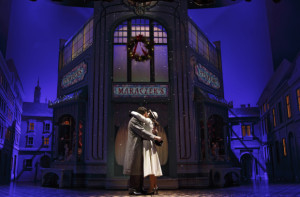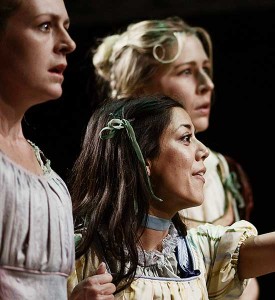I rarely have the luxury of seeing stage shows twice—my crowded reviewing schedule doesn’t allow it—but I did manage in recent days to see Bedlam’s Sense & Sensibility for the second time, and I’ll be doing the same thing tonight with the Roundabout Theatre Company’s revival of She Loves Me.
 In the case of She Loves Me, which figures prominently on my personal list of the greatest pre-Company American musicals, I’m returning to Studio 54 because Laura Benanti, one of the stars of the show, missed the Thursday-night preview that I saw last week. Laura Shoop, her understudy, went on instead and gave a terrific performance, nailing the notorious high C in “Ice Cream” and charming the audience so completely that she received the warmest of ovations at evening’s end. I can’t say more because I’m reviewing She Loves Me in Friday’s Wall Street Journal, but I can assure you that should Shoop ever go on again, you won’t be sorry in the least to see her.
In the case of She Loves Me, which figures prominently on my personal list of the greatest pre-Company American musicals, I’m returning to Studio 54 because Laura Benanti, one of the stars of the show, missed the Thursday-night preview that I saw last week. Laura Shoop, her understudy, went on instead and gave a terrific performance, nailing the notorious high C in “Ice Cream” and charming the audience so completely that she received the warmest of ovations at evening’s end. I can’t say more because I’m reviewing She Loves Me in Friday’s Wall Street Journal, but I can assure you that should Shoop ever go on again, you won’t be sorry in the least to see her.
The reason why I went back to the remounting of Eric Tucker’s staging of Sense & Sensibility, whose original production I saw in November of 2014, was that Mrs. T didn’t get to see it with me the first time around. She loves Jane Austen and Bedlam with identical fervor, so when she asked if I’d take her to the Sunday matinée, I unhesitatingly said yes.
My 2014 Wall Street Journal review, although brief, was as enthusiastic as it gets:
Great theater isn’t about fancy sets or famous actors (though it doesn’t necessarily exclude either). It’s about imagination and intimacy. Given enough of both, a band of gifted unknowns can make theatrical magic in an empty room. That’s what Bedlam Theatre Company is doing with its no-budget off-off-Broadway productions of “The Seagull” and “Sense and Sensibility,” which are playing in repertory in a black-box performance space in downtown Manhattan that looks like the inside of a grungy warehouse….
Instead of passively letting the action unfold before your eyes, you have to meet Bedlam halfway in your mind, for no attempt is made at conventional theatrical illusion: Men play women, women play men, people play animals. The décor amounts to a half-dozen cheap-looking chairs and tables, the costumes and lighting are dirt-plain and most of the audience is seated within arm’s length of the playing area. Yet the paradoxical result is a realism so persuasive that rather than viewing a pair of over-familiar “classics” for the umpteenth time, you feel as though you’re witnessing something that really happened, perhaps earlier today….
“Sense and Sensibility,” newly and skillfully dramatized by Bedlam’s Kate Hamill, merits far more attention than I can give it here. Suffice it to say that while Ms. Hamill has left the novel’s early-19th-century setting (and diction) intact, she and Mr. Tucker have steered clear of PBS-style costume-shop gentility, instead giving us a version so full of galloping comic vitality as to suggest a bunch of stupendously clever kids playing dress-up in the nursery. It’s by far the smartest Jane Austen adaptation to come along since Amy Heckerling’s “Clueless,” and at least as much fun.
It happens that I had to see the second preview of Sense & Sensibility, and was warned by the management that much last-minute work remained to be done on the production. You couldn’t have proved it by me. Many of the details of the staging were still vividly clear in my mind a year and a half later, enough so for me to realize that the performance of Sense & Sensibility that I saw on Sunday was significantly different from—and even better than—the one I reviewed in 2014.
 The biggest change, though, was in me. When you see a show for the first time, it comes at you as a a cloud of eventfulness, and even a trained observer is bound to have trouble grasping more than a sliver of what is happening on stage at any given moment, much less coming away with anything other than a necessarily fragmentary grasp of the total experience. When you see it for the second time, you’re no longer quite so overwhelmed, and can often think more clearly about what you’re seeing.
The biggest change, though, was in me. When you see a show for the first time, it comes at you as a a cloud of eventfulness, and even a trained observer is bound to have trouble grasping more than a sliver of what is happening on stage at any given moment, much less coming away with anything other than a necessarily fragmentary grasp of the total experience. When you see it for the second time, you’re no longer quite so overwhelmed, and can often think more clearly about what you’re seeing.
As I watched Sense & Sensibility for the second time, I realized that part of its uniqueness comes from the way in which Tucker, who is also Bedlam’s artistic director, has worked with his on- and off-stage collaborators to transplant avant-garde and expressionistic theatrical techniques into a popular, deliberately accessible context. On one level S & S is pure fun, a romp that combines the festive comic ingenuity of a twenty-door farce with the vaulting physicality of a ballet. But it is also, like everything Bedlam does, an extremely modern piece of work, one that uses anti-realistic devices—most notably a constantly shifting, at times quasi-cinematic point of view—to illuminate the inner lives of the principal characters in a deeply poetic way.
All this will make sense to anyone who’s read Bedlam’s mission statement:
Committed to the immediacy of the relationship between the actor and the audience, Bedlam creates theatre in a flexible, raw space and is interested in contemporary reappraisals of the classics, new writing and small-scale musical theatre.
Storytelling is paramount to us and the theatre we make always includes the audience in the story. We believe that innovative use of space can collapse aesthetic distance and bring the audience into direct contact with the dangers and delicacies of life.
 But mere words, however eloquent—and I include my own—cannot do more than hint at the overwhelming effect that Bedlam and its leader have had on me since I first reviewed the company four years ago. Now that I’ve seen S & S twice, I’m awestruck by Tucker’s burgeoning creativity, and by the way in which the marvelous actors with whom he now works more or less regularly have coalesced into a true theatrical ensemble, one of a handful to exist in this country. He is, in my opinion, the David Cromer of classical theater, one of the most radically original American stage directors of our time.
But mere words, however eloquent—and I include my own—cannot do more than hint at the overwhelming effect that Bedlam and its leader have had on me since I first reviewed the company four years ago. Now that I’ve seen S & S twice, I’m awestruck by Tucker’s burgeoning creativity, and by the way in which the marvelous actors with whom he now works more or less regularly have coalesced into a true theatrical ensemble, one of a handful to exist in this country. He is, in my opinion, the David Cromer of classical theater, one of the most radically original American stage directors of our time.
I hasten to add that I already felt that way before seeing Sense & Sensibility on Sunday. But seeing the show a second time was more than merely the confirmation of a long-standing feeling. It taught me new things about what theater can do, and inspired me, as Bedlam always does, to try taking more chances in my own theatrical life. That’s the highest compliment I know: seeing Bedlam makes me want to work harder, and be better.
UPDATE: Bedlam announced today that Sense & Sensibility, which is currently set to close April 17, will reopen on June 17 and run through October 2.
* * *
A panel discussion about Bedlam’s stage version of Sense & Sensibility, featuring members of the cast and production team:


